MP Board Class 10th Science Solutions Chapter 11 Human Eye and Colourful World
MP Board Class 10th Science Chapter 11 Intext Questions
Class 10th Science Chapter 11 Intext Questions Page No. 190
Question 1.
What is meant by power of accommodation of the eye?
Answer:
The ability of the eye to focus the distant objects as well as the nearby objects on the retina by changing focal length or converging power of its lens is called accommodation. The normal eye has a power of accommodation which enables the object as close as 25cm & as far as infinity to be focused on its retina.
Question 2.
A person with a myopic eye can not see objects beyond 1.2 m distinctly. What should be the type of the corrective lens used to restore proper vision?
Answer:
The person is able to see nearby objects clearly, but he is unable to see objects beyond 1.2m. This happens because the image of an object beyond 1.2 m is formed in front of the retina and not at the retina, as shown in the figure.

To correct this defect of vision, he must use a concave lens. The concave lens will bring the image back to the retina is shown in the given figure.

Fig. 11.1 Myopic eyes and their correction.
Question 3.
What is the far point and near point of the human eye with normal vision?
Answer:
Far point of the human eye with normal vision is near than infinity and near point is 1.2 m.
Question 4.
A student has difficulty reading the blackboard while sitting in the last row. What could be the defect the child is suffering from? How can it be corrected?
Answer:
A student has difficulty reading the black board while sitting in the last row means he is suffering from myopia. This defect can be corrected using concave lens of suitable power.
![]()
MP Board Class 10th Science Chapter 11 NCERT Textbook Exercises
Question 1.
The human eye can focus objects at different distances by adjusting the focal length of the eye lens. This is due to:
(a) presbyopia
(b) accommodation
(c) near-sightednes
(d) far-sightedness
Answer:
(b) Human eye can change the focal length of the eye lens to see the objects situated at various distances from the eye. This is possible due to the power of accommodation of the eye lens.
Question 2.
The human eye forms the image of an object at its:
(a) cornea
(b) iris
(c) pupil
(d) retina
Answer:
(d) The human eye forms the image of an object at its retina.
Question 3.
The least distance of distinct vision for a young adult with normal vision is about
(a) 25 m.
(b) 2.5 cm
(c) 25 cm
(d) 2.5 m
Answer:
(c) 25 cm
Question 4.
The change in focal length of an eye lens is caused by the action of the
(a) pupil.
(b) retina
(c) ciliary muscles
(d) iris
Answer:
(c) ciliary muscles
Question 5.
A person needs a lens of power – 5.5 dioptres for correcting his distant vision. For correcting his distant vision. For correcting his near vision he needs a lens of power + 1.5 dioptre. What is the focal length of the lens required for correcting (i) distinct vision, and (ii) near vision?
Answer:
i) Lens required for correcting
distant vision = – 5.5
Focal length of lens F \(=\frac{1}{P}\)
\(\mathrm{F}=\frac{1}{-5.5}=0.181 \mathrm{m}\)
Lens required for correcting this defect =-0.181 M
ii) Lens required for correcting near vision = + 1.5 D
Focal length of lens F \(=\frac{1}{P}\)
\(F=\frac{1}{1.5}=0.667 \mathrm{m}\)
Question 6.
The far point of a myopic person is 80 cm in front of the eye. What is the nature and power of the lens required to correct the problem?
Answer:
The person is suffering from an eye defect called myopia. In this defect, the image is formed in front of the retina. Hence, a concave lens is used to correct this defect of vision.
Object-distance, u = infinity
Image-distance, v = -80 cm
Focal length = f
According to the lens formula,

A concave lens of Power – 1.25 D is required by the person to correct his defect.
Question 7.
Make a diagram to show how hypermetropia is corrected. The near point of a hypermetropic eye is 1 m. What is the power of the lens required to correct this defect? Assume that the near point of the normal eye is 25 cm.
Answer:
A person suffering from hypermetropia can see distinct objects clearly but faces difficulty in seeing nearby objects clearly. It happens because . the eye lens focuses the incoming divergent rays beyond the retina. This defect of vision is corrected by using a convex lens. A convex lens of suitable power converges the incoming light in such a way that the image is formed on the retina, as shown in the following figure.

Fig. 11.2: Correction for hypermetropic eye.
The convex lens actually creates a virtual image of a nearby object (N’ in the figure) at the near point of vision (N) of the person suffering from hypermetropia. The given person will be able to clearly see the object kept at 25 cm (Near point of the normal eye), if the image of the object is formed at his near point, which is given as 1 m.
Object-distance, u = -25 cm
Image-distance, v = -1m = -100m
Focal length, f = ?
Using the lens formula,
\(\frac { 1 }{ v } \) – \(\frac { 1 }{ u } \) = \(\frac { 1 }{ f } \)
\(\frac { 1 }{ -100 } \) – \(\frac { 1 }{ -25 } \) = \(\frac { 1 }{ f } \)
\(\frac { 1 }{ f } \) = \(\frac { 1 }{ 25 } \) = \(\frac { 1 }{ f } \)
\(\frac { 1 }{ f } \) = \(\frac { 1 }{ 25 } \) – \(\frac { 1 }{ 100 } \)
\(\frac { 1 }{ f } \) = \(\frac { 4-1 }{ 100 } \)
f = \(\frac { 100 }{ 3 } \) = 33.3 cm = 0.33cm
![]()
A convex lens of power + 3.0 D is required to correct the defect.
Question 8.
Why is a normal eye not able to see clearly the objects placed closer than 25 cm?
Answer:
The maximum accommodation of a normal eye is reached when the object is at a distance of 25 cm from the eye. The focal length of the eye lens cannot be decreased below this minimum limit. Thus an object placed closer than 25cm [or very close to eye] cannot be seen clearly by a normal eye.
Question 9.
What happens to the image distance in the eye when we increase the distance of an object from the eye?
Answer:
The distance eye lens and retina is the image distance inside the eye. The image distance is fixed. It cannot be changed at all. Therefore, when we increase the distance of an object from the eye, there is no change in the image distance inside the eye.
Question 10.
Why do stars twinkle?
Answer:
Stars emit their own light and they twinkle due to the atmospheric refraction of light. Stars are very far away from the earth. Hence, they are considered as point sources of light. When the light coming from stars enters the earth’s atmosphere, it gets refracted at different levels because of the variation in the air density at different levels of the atmosphere. When the star’s light refracted by the atmosphere comes more towards us, it appears brighter than when it comes less towards us. Therefore, it appears as if the stars are twinkling at night.
Question 11.
Explain why the planets do not twinkle.
Answer:
Planets do not twinkle because they appear larger in size than the stars as they are relatively closer to earth. Planets can be considered as a collection of a large number of point-size sources of light. The different parts of these planets produce either brighter or dimmer effect in such a way that the average of brighter and dimmer effect is zero. Hence, the twinkling effects of the planets are nullified and they do not twinkle.
Question 12.
Why does the Sun appear reddish early in the morning?
Answer:
Light from the Sun near the horizon passes through thicker layers of air and larger distance in the earth’s atmosphere before reaching our eyes. However, light from the Sun overhead would travel relatively shorter distance. At noon, the Sun appears white as only a little of the blue and violet colours are scattered. Near the horizon, most of the blue light and shorter wavelengths are scattered away by the particles. Therefore, the light that reaches our eyes is of longer wavelengths. This gives rise to the reddish appearance of the Sun.
Question 13.
Why does the sky appear dark instead of blue to an astronaut?
Answer:
When sunlight passes through the atmosphere, the fine particles in air scatter the blue colour (shorter wavelength more strongly than red. The scattered blue light enters our eyes. If the earth had no atmosphere, there would not have been any scattering. Then the sky would have looked dark. The sky appears dark to astronaut flying at very high attitude, as scattering is not prominent at such heights.
![]()
MP Board Class 10th Science Chapter 11 Additional Important Questions
MP Board Class 10th Science Chapter 11 Multiple Choice Questions
Question 1.
When our eye see a near object, its lens?
(a) Expand
(b) Remain same
(c) Contract
(d) None
Answer:
(a) Expand
Question 2.
What transfer information from eyes to brain?
(a) Neuro trans
(b) Iris
(c) Optical nerve
(d) Retina
Answer:
(c) Optical nerve
Question 3.
What controls the size of pupil?
(a) Iris
(b) Cornea
(c) Lens
(d) Aqueous humour
Answer:
(a) Iris
Question 4.
Near point of human eye is approximately:
(a) 50 cm
(b) 1 m
(c) 25 cm
(d) 25 m
Answer:
(c) 25 cm
Question 5.
Far point of human eye is approximately:
(a) 10 km
(b) infinity
(c) 5 km
(d) 25 cm
Answer:
(a) 10 km
Question 6.
Cataract is caused mostly to
(a) Farm workers
(b) Factory workers
(c) Kids watching TV and Mobiles
(d) Old age people
Answer:
(d) Old age people
Question 7.
In which kind of defect, image of a distant object is formed in front of retina?
(a) Myopia
(b) Cataract
(c) Hypermetropia
(d) Presbyopia
Answer:
(a) Myopia
Question 8.
A concave lens with correct power can help a person with
(a) Hypermetropia
(b) Myopia
(c) Presbyopia
(d) None of these
Answer:
(b) Myopia
Question 9.
Adjusting “cording to object’s distance from eye is called
(a) Vision power
(b) Motivation
(c) Accommodation power
(d) Presbyopia
Answer:
(c) Accommodation power
Question 10.
For an eye donation, eyes must be removed within ……… after death.
(a) 8 hours
(b) 25 hours
(c) 4-6 hours
(d) None.
Answer:
(c) 4-6 hours
Question 11.
What type of lens are required to correct a vision of hypermetropic eyes?
(a) Concave
(b) Convex
(c) both
(d) Plane mirror is required ;
Answer:
(b) Convex
Question 12.
When we pass a light through a prism, it is
(a) Refracted
(b) Scattered
(c) Reflected
(d) Inverted
Answer:
(a) Refracted
Question 13.
Which colour lies in centre of a rainbow?
(a) Red
(b) Violet
(c) Yellow
(d) Green
Answer:
(d) Green
Question 14.
If two prism are placed inverted to each other and white light is passed from one prism, what will we get refracted by other prism?
(a) VIBGYO
(b) white light
(c) All light will be absorbed
(d) Black spot
Answer:
(b) white light
Question 15.
We see twinkling of stars due to:
(a) Reflection of light.
(b) Refraction of light
(c) Scattering of light
(d) Polarization of light
Answer:
(b) Refraction of light
Question 16.
Particle looks moving in smoke filled place, when a light beam coming from a whole passes through it, because:
(a) Tyndall effect
(b) atmospheric refraction
(c) White light spectrum
(d) reflection
Answer:
(a) Tyndall effect
![]()
MP Board Class 10th Science Chapter 11 Very Short Answer Type Questions
Question 1.
Where image is formed in our eyes?
Answer:
Retina.
Question 2.
Which part of eye helps in adjustment of lens according to distance?
Answer:
Lens.
Question 3.
Which nerve transfer information regarding image to brain?
Answer:
Optic nerve.
Question 4.
What is power of accommodation?
Answer:
The ability of the eye to focus both near and distant objects, by adjusting its focal length is called power of accommodation of eyes.
Question 5.
How many points of accommodation are set to observe clarity of a person’s vision?
Answer:
Two-far point and near point.
Question 6.
What is the maximum distance till which a person with normal eye can see?
Answer:
No limit, infinite distance.
Question 7.
Name common refractive defects of eyes.
Answer:
Myopia, Hypermetropia and Presbyopia.
Question 8.
What kind of lens is used to correct a myopic defect in a person?
Answer:
Concave.
Question 9.
What kind of treatment is available to correct a cataract?
Answer:
Surgery.
Question 10.
What is bifocal lens?
Answer:
Lens made by both concave and convex lens is called bifocal lens.
Question 11.
What happens to the light ray entering a prism?
Answer:
The light ray get refracted.
Question 12.
What happens if white light is passed through a prism?
Answer:
It Scatters to seven colours spectral pattern.
Question 13.
What is an emergent ray?
Answer:
Ray which comes out after being refracted from a prism is called emergent ray.
Question 14.
Why sky looks red at sunrise and sunset?
Answer:
Scattering of white light.
Question 15.
Which colour light bend most after coming out of a triangular prism?
Answer:
Violet.
Question 16.
Why we never see a shadow without light?
Answer:
When light passes through an object, it get partially deviated or absorbed so, disappear from that very way which forms a shadow.
Question 17.
Why light ray in a dusty room look sparkling and moving?
Answer:
Due to tyndall effect.
Question 18.
Why we can observe a star twinkling?
Answer:
Due to atmospheric refraction.
Question 19.
What is the time difference between actual and observed sunrise and sunset?
Answer:
2 minutes.
Question 20.
Why sky looks blue to all of us?
Answer:
Due to scattering of light.
![]()
MP Board Class 10th Science Chapter 11 Short Answer Type Questions
Question 1.
Why does the Sun appear reddish early in the morning?
Answer:
Early in the morning, the sun is near the horzion. Sunlight reaches us after covering a large thickness of the atmosphere. So, shorter waves of blue region are almost completely scattered away by the air molecules. Red waves of longer wavelength are least scattered and reach our eyes. The sun appears red.
Question 2.
Why does the sky appear dark instead of blue to an astronaut?
Answer:
The atmosphere is quite thin at very high altitudes. There is almost no scattering of sunlight. So, the sky appears dark to an astronaut.
Question 3.
Why is a concave lens used to correct myopia or short-sightedness?
Answer:
A concave lens of suitable focal length diverges the parallel rays from the distant object as if they are coming from the far point F of the myopic eye. This helps the eye lens to form a clear image at the retina.
Question 4.
Dispersion is caused by refraction not by reflection. Why?
Answer:
The reason is that for a given angle of incidence, the angle of reflection is same for all the wavelengths of white light while the angle of refraction is different for different wavelengths.
Question 5.
A hypermetropic person prefers to remove his spectacles, while driving. Give reason.
Answer:
When a hypermetropic person wearing the spectacles looks at a distant object, the parallel rays from the distant object get converged in front of the retina. The image appears blurred. In order to avoid this, the person prefers to remove his spectacles.
Question 6.
Give reasons for the following:
- The stars appear to twinkie.
- The planets do not twinkle.
Answer:
- Stars appear to twinkle due to atmospheric refraction of starlight and physical conditions of the earth’s atmosphere are not being stationary.
- Planets are much closer to the earth and are seen as extended sources. The fluctuations caused in the amount of light due to atmospheric refraction are negligible. Hence, planets do not twinkle.
![]()
MP Board Class 10th Science Chapter 11 Long Answer Type Questions
Question 1.
Why does the Sun seem to rise two minutes before the actual sunrise and set two minutes after the actual sunset? Explain with the help of labelled diagram.
Answer:
Advance sunrise and delayed sunset. Apparent shift in the position of sun at sunrise and sunset:
The sun is visible before actual sunrise and after actual sunset, because of atmospheric refraction. With altitude, the density and hence, refractive index of air-layer decreases. As shown in Fig. given the light rays starting from the sun travel from rarer to denser layers. They bend more and more towards the normal. To an observer on the earth, light rays appear to come from position S. The sun which is actually in position S below the horizon appears in position S above the horizon.
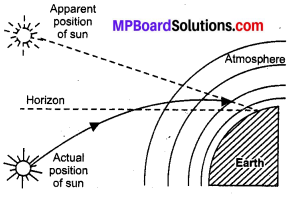
Fig. 11.6: Atmospheric refraction effect at sun rise.
Thus, the sun appears to rise early by about two minutes and for the same reason, it appears to set late by about two minutes. This increases the length of the day by about four minutes.
Question 2.
“Stars appear higher than they actually are.” Give reason.
Or
Is the position of a star as seen by us its true position? Justify your answer.
Answer:
Since, the atmosphere bends starlight towards the normal, the apparent position of the star is slightly different from its actual position. The stars appear slightly higher (above) than their actual position when viewed near the horizon.
Question 3.
Why do we observe the apparent random wavering or flickering of objects when seen through a turbulent stream of hot air rising above fire, a stove or radiator?
Answer:
This is due to atmospheric refraction i.e., refraction of light by the earth’s atmosphere. The air just above the fire becomes hotter than air further up. Hotter air is lighter (less denser) than the cooler air (denser) above it. This causes refraction of light due to decrease of refractive index with decreasing density or increasing temperature. Since, the physical conditions of the refracting medium (air) are not stationary, the apparent positions of the objects, as seen through the hot air, fluctuate. Consequently, the objects seen through such air show a wavering effect.
Question 4.
Why do we see stars appear twinkling whereas planets do not twinkle?
Or
A star sometimes appear brighter and some other times fainter. What is this defect called, state reason for this effect.
Answer:
Twinkling of stars: Differential the apparent position of a star is slightly different from the actual position due to refraction of starlight by the atmosphere. Further, this apparent position is not stationary but keeps on changing due to the change in atmospheric conditions like density, temperature etc. The path of the rays of light coming from the star goes on varying slightly. The amount of light entering our eyes from a particular star increases or decreases randomly with time.
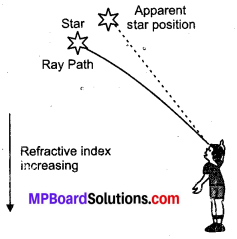
Fig. 11.7: Apparent star position due to atmospheric refraction.
Sometimes, the star appears bright and other times, it appears fainter. This gives rise to the twinkling effect of the star.
The planets do not show twinkling effect. As the planets are much closer to the earth, the amount of light received from them is much greater and the fluctuations caused in the amount of light due to atmospheric refraction are negligible as compared to the amount of light received from them.
Question 5.
What is tyndall effect? What is its cause? Name two phenomena observed in daily life which are based on Tyndall effect.
Or
A beam of light is allowed to pass through two beakers A and B containing a true solution and colloidal solution respectively. What do you observe? Name the phenomenon responsible for your observation.
Answer:
Tyndall effect: When a beam of light is passed through a colloidal solution, placed in a dark room, the path of beam becomes illuminated (or visible), when observed through a microscope placed perpendicular to the path of light. This effect is called Tyndall effect.
On the other hand, the path of a beam of light is not visible through a true solution, as shown in figure 11.8.
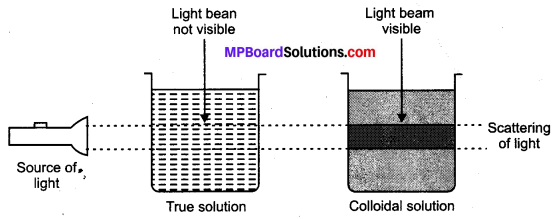
Fig. 11.8: Tyndall effect.
Cause of Tyndall effect: The size of the colloidal particle is relatively larger than the solute particle of a true solution. The colloidal particles first absorb energy from the incident light and then scatter a part of this energy from their surfaces. Thus, Tyndall effect is due to scattering of light by the colloidal particles and the colloidal particles are seen as points of light moving against a dark background.
Some daily life phenomena based on Tyndall effect are as follows:
- When a fine beam of sunlight enters a smoke filled room through a small hole, the smoke particles become visible due to the scattering of light.
- When sunlight passes through a canopy of a dense forest, the tiny water droplets in the mist scatter light and become visible.
![]()
MP Board Class 10th Science Chapter 11 NCERT Textbook Activities
Class 10 Science Activity 11.1 Page No. 192
- Fix a sheet cf white paper on a drawing board using drawing pins.
- Fife a glass prism on it in such a way that it rests on its triangular fee. Trace the outline of the prism using a pencil.
- Draw a straight line PE inclined to one of the refracting surfaces, say AB, of the prism.
- Fix two pins, say at points P and Q, on the line PE as shown in Fig. 11.3.
- Look for the images of the pins, fixed at P and Q, through the other face AC.
- Fix two more pins, at points R and S, such that the pins at R and S and the images of the pins at P and Q lie on the same straight line.
- Remove the pins and the glass prism.
- The line PE meets the boundary of the prism at point E (see Fig. 11.3). Similarly, join and produce the points R and S. Let these lines meet the boundary of the prism at E and F, respectively. Join E and F.
- Draw perpendiculars to the refracting surfaces AB and AC of the prism at points E and F, respectively.
- Mark the angle of incidence (∠i), the angle of refraction (∠r) and the angle of emergence (∠e) as shown in Fig. 11.3.
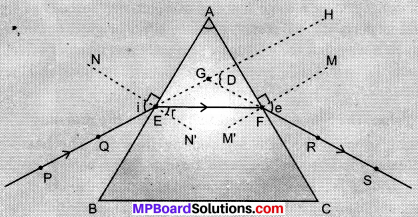
PE – Incident ray – ∠i – Angle of incidence
EF – Refracted ray ∠r – Angle of refraction
FS – Emergent ray ∠e – Angle of emergence
∠A – Angle of the prism – ∠D – Angle of deviation
Fig. 11.3 : Refraction of tight through a triangular glass prism
Observations:
- The light rays enter the prism and emerge out as the emergent ray. The light ray bent towards the normal upon refraction. At the second surface, the light ray enters from glass to air. The emergent ray appears to be coming along the rays FRS, the angle between the incident ray produced forward and the emergent ray produced backward, is called the angle of deviation.
Class 10 Science Activity 11.2 Page No. 193
- Take a thick sheet of cardboard and make a small hole or narrow slit in its middle.
- Allow sunlight to fall on the narrow slit. This gives a narrow beam of white light.
- Now, take a glass prism and allow the light from the slit to fall on one of its faces as shown in Fig. 11.4.
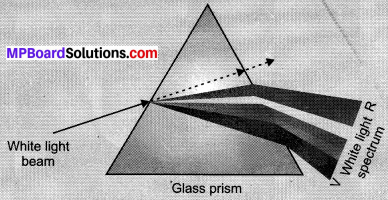
Fig. 11.4: Dispersion of white light by the glass prism. - Turn the prism slowly until the light that comes out of it appears on a nearby screen.
- What do you observe? You will find a beautiful band of colours. Why does this happen?
Observations:
- The white light gets dispersed into seven colour components by a prism. The band of the coloured components of a light beam is called spectrum. The splitting of light into its component colours is called dispersion. The colours bends at different angles as they pass through prism and are observed separately as VIBGYOR.
Class 10 Science Activity 11.3 Page No. 196
- Place a strong source (S) of white light at the focus of a converging lens (L). This lens provides a parallel beam of light.
- Allow the light beam to pass through a transparent glass tank containing clear water.
- Allow the beam of light to pass through a circular hole (e) made in a cardboard. Obtain a shaip image of the circulai hole on a screen (MN) using a second converging lens (L2), as shown in Fig. 11.5
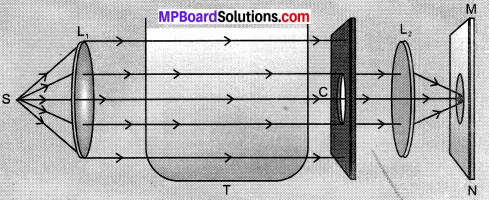
Fig. 11.5: An arrangement for observing scattering of light in colloidal solution. - Dissolve about 200 g of sodium thiosulphate (hypo) in about 2 L of clean water taken in the tank. Add about 1 to 2 mL of concentrated sulphuric acid to the water. What do you observe?
Observations:
- The microscopic particles of sulphur precipitate, in about 2 to 3 minutes. As they precipitate, the blue light from the three sides of the glass tank is seen. This happens due to scattering of short wavelengths by minute colloidal sulphur particles.